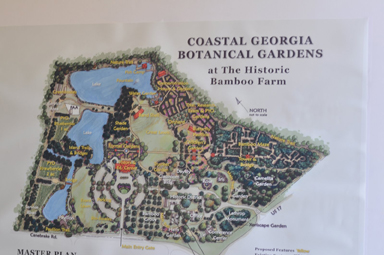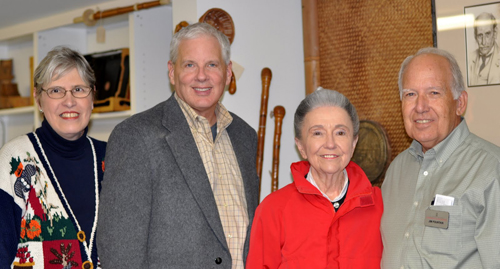More than 550 items — from yard rakes and flutes to medicine containers and pigeon whistles, all made from bamboo – are now on display at the new Bamboo Artifact Museum at the University of Georgia Coastal Georgia Botanical Gardens at the Historical Bamboo Farm in Savannah, Ga.
From the early 1900s to 1979, scientists collected these items as they travelled the world seeking unusual plants. They donated them to the U.S. Department of Agriculture’s Bamboo Farm in Savannah. When the USDA station closed in 1979, the artifacts were shipped to Washington and displayed or stored at the Smithsonian and other museums.
The UGA College of Agricultural and Environmental Sciences and Chatham County now manage the bamboo farm.
CAES Dean and Director Scott Angle and the garden’s superintendent Jim Fountain arranged for the artifacts to return to their original home in Georgia. The bamboo collection is now housed in the museum, and Richmond Hill artist Sarah Volker adorned the walls with a bamboo mural.
More than 1,200 families attended the museum’s dedication Oct. 22. The ceremony coincided with the Savannah Rose Society’s Rose Show.
During the event, 3,000 children took pony, tram and train rides, had their faces painted by volunteer artists, painted pumpkins, made leaf prints, learned about plants, earthworms and chickens and participated in a scarecrow-making contest sponsored by the Friends of the Coastal Gardens and Goodwill Industries.
A master plan has been developed to transform the gardens into a world-class botanical garden. The estimated cost for the first phase of the plan is $4 million.
To date, $1.3 million in challenge grants have been pledged by local donors to build a visitor and educational center overlooking a formal garden, water garden and the only bamboo maze in the Western Hemisphere.
Some $700,000 has been used for infrastructural improvements necessary to implement the plan, said Fountain.
The first phase of the plan will include a world-class children’s garden, a lawn and band shell for outdoor events, a shade garden, numerous walking and nature trails and a replica of the 1730s Trustees Garden, which was America’s first agricultural research station. Demonstration, trail, research and pick-your-own gardens are also included in the first phase of the project. “In addition, we plan to expand the research and extension educational programming,” Angle said.
The gardens currently house four major plant collections: the oldest and largest bamboo collection in the country with more than 60 species; the largest iris cultivar collection east of the Mississippi River; a collection of 35 palm species; and the most diverse collection of camellia species and cultivars outside of Asia. The garden is home to the nation’s largest Lords Holly tree.
“We currently host more than 100,000 visitors each year at the coastal garden,” Angle said. “Within five years of implementing phase I, it’s estimated 500,000 individuals will visit the garden annually. We hope the improvements at the facility will increase tourism in the area by offering a unique experience for Georgia’s coastal region.”





